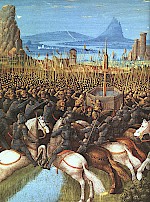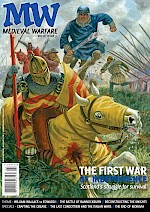News update 4 July 2014
 This is our news update of Friday 4 July. We are very busy with the final stages of Medieval Warfare IV-4. It should got to print in about 1,5 weeks. In the meantime, we have some nice facts to help you get through the next couple of days.
This is our news update of Friday 4 July. We are very busy with the final stages of Medieval Warfare IV-4. It should got to print in about 1,5 weeks. In the meantime, we have some nice facts to help you get through the next couple of days.
Today, 827 years ago, the Ayyubid leader Saladin and his army met the army of Guy of Lusignan, King of Jerusalem. Making use of the impetuousness of Guy and his commanders, Saladin manages to lure the mixed Christian army into dry terrain while blocking their access to any near water. Having marched miles, without sufficient water, and continuously being harassed by Muslim horse archers, the Christian army becomes weak, and easy prey for Saladin’s army. The crusader army was defeated, Guy was captured, and the road was now open for Saladin to besiege Jerusalem, where he was temporarily stalled by Balian of Ibelin. The fall of Jerusalem sparked the start of the Third Crusade, which will be covered in Medieval Warfare IV-5, the theme of which focuses on Richard I’s campaigns in the Mediterranean.
Also:
 - On 5 July 1295, Scotland and France form the so-called ‘Auld Alliance’ against England, signed by Scottish king John Baliol and French king Philip IV. The alliance would be in effect up throughout the remainder of the Middle Ages (with the exception of the reign of Louis XI; also see our upcoming issue Medieval Warfare IV-4), up until the early Modern period. It made sure that the French would come to the aid of Scotland in case of war with England, as well as the other way around, either in the form of providing troops and money, or by actively waging war. Thus, Scottish soldiers were involved during the Hundred Years War, while French aid was given to the Scots during the Scottish War of Independence. See Medieval Warfare IV-3 for more information, and make sure you read Tobias Capwell’s online article on this website.
- On 5 July 1295, Scotland and France form the so-called ‘Auld Alliance’ against England, signed by Scottish king John Baliol and French king Philip IV. The alliance would be in effect up throughout the remainder of the Middle Ages (with the exception of the reign of Louis XI; also see our upcoming issue Medieval Warfare IV-4), up until the early Modern period. It made sure that the French would come to the aid of Scotland in case of war with England, as well as the other way around, either in the form of providing troops and money, or by actively waging war. Thus, Scottish soldiers were involved during the Hundred Years War, while French aid was given to the Scots during the Scottish War of Independence. See Medieval Warfare IV-3 for more information, and make sure you read Tobias Capwell’s online article on this website.
 - Sunday 6 July marks the anniversary of the Battle of Fornovo, during which French King Charles VIII defeats the Holy League consisting of the Republic of Venice, the Duchy of Milan and the Duchy of Mantua. It was the first major battle of the Italian Wars, which were waged intermittently between 1494-1559, and which saw many of the major European nations becoming involved. The Battle of Fornovo showed the world that, even though the Italian States were rich, they could not field armies comparable to the large Kingdoms in Europe, thus creating a precept for a long period of shifting alliances. A major phase of the Italian Wars was the War of the League of Cambrai, which is the theme of Medieval Warfare II-5.
- Sunday 6 July marks the anniversary of the Battle of Fornovo, during which French King Charles VIII defeats the Holy League consisting of the Republic of Venice, the Duchy of Milan and the Duchy of Mantua. It was the first major battle of the Italian Wars, which were waged intermittently between 1494-1559, and which saw many of the major European nations becoming involved. The Battle of Fornovo showed the world that, even though the Italian States were rich, they could not field armies comparable to the large Kingdoms in Europe, thus creating a precept for a long period of shifting alliances. A major phase of the Italian Wars was the War of the League of Cambrai, which is the theme of Medieval Warfare II-5.
